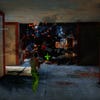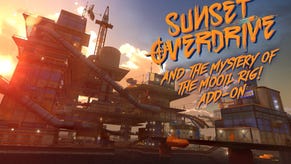Digital Foundry vs Sunset Overdrive
How does Insomniac's tech fare on Xbox One?
Sunset Overdrive is a game that dares to be different to other third-person shooters, turning its back on the overly serious tone of today's top-end releases in favour of a bright and colourful aesthetic, with gameplay clearly influenced by Sega's Jet Set Radio and Sucker Punch's inFamous. With flashy aerial acrobatics and wacky cartoon-like shooting, Sunset Overdrive is a breath of fresh air, putting the fun factor ahead of complex storylines or laboured attempts at grim and gritty realism.
Built around a dramatically reworked version of the engine that powered Insomniac's ill-fated Fuse, the technology in Sunset Overdrive is optimised specifically for Xbox One hardware, targeting 30fps instead of the slick 60fps update previously favoured by the developer in Ratchet and Clank. At this year's E3 it was clear Insomniac hadn't quite nailed a solid 30fps, resulting in gameplay that sometimes felt a little heavy as the frame-rate took significant dives. The final game is much improved: the impressive graphical standards at E3 remain, but performance is smoother under load and the general consistency of the refresh is commendable bearing in mind the often insane visuals, especially in multiplayer.
While controller response obviously compares unfavourably to games with 60Hz presentation, the switch to a lower frame-rate allows Insomniac to ramp up the detail and number of characters on-screen, while the lavish effects work is exemplary. This is particularly important since Sunset Overdrive is all about over-the-top action and stylish excess, and a reduction in these elements would radically alter the fundamentals.
On top of that, the developer has given Sunset Overdrive a rich open-world playground, where it's possible to scale the tallest buildings and traverse the entire landscape without touching the ground. While it only takes three minutes to go from end to end, this relatively compact environment allows the developer to fill it out with plenty of detail and interesting locations, providing a wealth of interactive objects with which to combo moves and attacks.
The beautiful environments are engineered around the idea of gaining momentum as you jump, grind and slide around Sunset City: long lines and bounce pads close to the ground make it easy to gain some quick air-time. As you make your way higher up into the skyline, well-executed wall-runs, pipe swings and slides are required to maintain momentum without crashing to the ground. The longer your combination of jumps, grinds and kills, the more powerful you become, unlocking abilities and attracting more dangerous foes. This adds a distinct level of skill to the simple gameplay mechanics, since more powerful abilities are unlocked by building up style points that dissipate over time if you fail to keep a combo going.
Get things right and the gameplay blurs into a mix of high-speed aerial acrobatics and a sea of green goo, smoke and particles - a lavish technological mix. The use of camera and object blur adds ferocity to melee combat in addition to giving the experience a more cinematic feel, while high-powered weapons cause the screen to shake and distort. Another nice touch is the way enemies sometimes explode into the word 'pop' as they are blown apart, showcasing what is suggestive of physics-driven fluid simulation. It's a truly impressive sight that makes smaller battles more exciting, and creates scenes of absolute mayhem up against scores of enemies in multiplayer Chaos Squad mode. Despite the carnage caused during full-on shootouts, alpha effects are still delivered at full resolution, while animated particles float across the screen en masse.
Sunset Overdrive is a promising showcase of game design and technology fused together to provide some entertainment, then, infused with comic ultra-violence, and when all the pieces comes together the experience can be superb, but we should point out that Sunset Overdrive isn't quite the perfect package. While Sunset City is brimming with architectural detail, it also feels a little lifeless at times, mainly due to the lack of scattered survivors on the streets, especially outside scripted sequences during missions.
From a technical perspective, some of the smoke and fire effects appear a little flat too, and environmental damage is limited so it never feels like the chaos you are causing has a substantial effect on anything other than the enemies you are slaughtering. Even so there are some more subtle effects, such as glass windows in vehicles cracking and shattering upon impact, and surfaces taking on a charred appearance in the aftermath of an explosion.
Away from the relentlessness of combat, speeding past the scenery while grinding high up above the cityscape reveals draw distances that are particularly impressive, showcasing just how much detail Insomniac's engine can push out at any given time - distant buildings and other features are visible well into the horizon. Textures are styled in a hand-drawn manner and are designed to give the game a surreal, almost comic-book feel. Despite this, the team still manages to infuse realism into the game via advanced surface shaders and an impressive real-time lighting model.
Materials reflect light accurately, while real-time reflections are also deployed on shiny surfaces, although the effect only appears to cover static scenery and not dynamic objects such as characters and particles. These effects are backed up with a custom lighting model that does a great job of realising a sun-drenched city paradise in the midst of a crazy viral outbreak. Contrast levels are high, delivering the full force of the afternoon sun in open areas, while parts of the city bathed in shade see HDR bloom and lens flare shine through between the buildings.
Insomniac stores dynamic lights in a linked list accessible per-pixel for all the elements in a game scene. The technique renders dynamic light sources more quickly over alternative deferred approaches, but also allows for transparency effects and particles to receive both light and shadow, further adding to the spectacle on offer when blasting your way through scores of mutants and Fisco drones.
The combination of Insomniac's vibrant artwork and technical flair leads to some incredible views. However, these vistas are let down by the appearance of noticeable level-of-detail transitions between lower and higher resolution artwork, along with some aliasing issues. The 900p framebuffer isn't really at fault here: despite fine details appearing a little soft, scaling quality is generally excellent, leading to well defined sub-pixel imagery and a reasonably crisp presentation.
Instead, the problem lies with the game's post-process anti-aliasing solution, which can leave plenty of jaggies on-screen, leading to frequent shimmering around objects more than a few metres away from the camera. While this doesn't ruin the impressive detail and accomplished effects work, it proves a tad distracting when scoping out far-reaching views from altitude. That said, the decision to render at sub-1080p is arguably the right choice for the game, where the extra power per-pixel is better spent in helping maintain a stable frame-rate while pushing lots of effects on-screen. The movement, consistency and fluidity of the game is worth more to the player than what would be a small bump to the crispness of the visuals.
During our time with the single-player campaign, Sunset Overdrive delivered a mostly solid 30fps, only disrupted by occasional minor drops in frame-rate - a clear improvement over the shakier build demoed at E3. Indeed, dropped frames mostly goes unnoticed as your attention is directed towards precise wall-runs and split-second headshots. At worst, frame-rates occasionally down to the upper twenties when the engine is heavily taxed. The use of a 900p framebuffer clearly pays dividends here, as even when the screen is littered with particle effects and goop from exploding enemies, overall consistency remains impressive.
The situation is a touch different for the Chaos Squad online multiplayer portion of the game. It's considerably more demanding on resources, with up to eight players all potentially occupying the screen with explosive projectiles and oceans of outlandish visual effects. The increased level of ferocity over the campaign missions causes heavier lapses in smoothness under load: in these situations, the heavy use of alpha effects causes frame-rates to briefly drop down to around 26fps in worst-case scenarios, adding an unwanted heaviness to the controls.
The game appears to use an adaptive v-sync, with screen-tear manifesting only at the very top of the screen. A locked 30fps title has a tight 33ms window to prepare the next frame - by flipping the framebuffer a little later (while the screen is refreshing, causing the tear), Insomniac can reduce frame-rate drops and improve controller latency. It's a trick used by many developers and it works well enough here, with no noticeable impact to image integrity during gameplay.
Sunset Overdrive - the Digital Foundry verdict
Sunset Overdrive represents an interesting evolution for Insomniac Games. While the game shares some technical underpinnings with Fuse, the experience is dramatically different, switching more traditional shooting for a fully explorable city containing platform action and blasting clearly influenced by the likes of Jet Set Radio alongside the studio's own Ratchet and Clank series. Far more important than the tech is the sense that the Insomniac DNA itself has transitioned across beautifully into the new console era: the developer's love for outlandish weaponry and interesting opportunities for layered level design comes through in spades, and the mixture is more impressive in scope and just as much fun as its titles on last-gen platforms.
From a technological perspective, it's a solid showcase. While 900p resolution may be a concern in some scenarios, this game doesn't rely on the kind of single-width pixel geometry or high-frequency texture detail that looks best at native 1080p, and the upscaling technique used here is a good match for the artwork. The 30fps target may disappoint Insomniac purists, but it's a relatively solid lock and clearly instrumental in rendering the sheer volume of outrageous art and effects work.
Overall, we rather like this first next-gen effort from Insomniac. The game is a lot of fun and Microsoft deserves kudos for investing in a title that feels fresh and different. Insomniac has been given free rein to create an entertaining new IP that also serves as a solid technical demonstration of what the Xbox One is capable of, while playing to the studio's strengths in gameplay and weapon design. It's not an Xbox One killer app, but it's a highly worthwhile title.












































